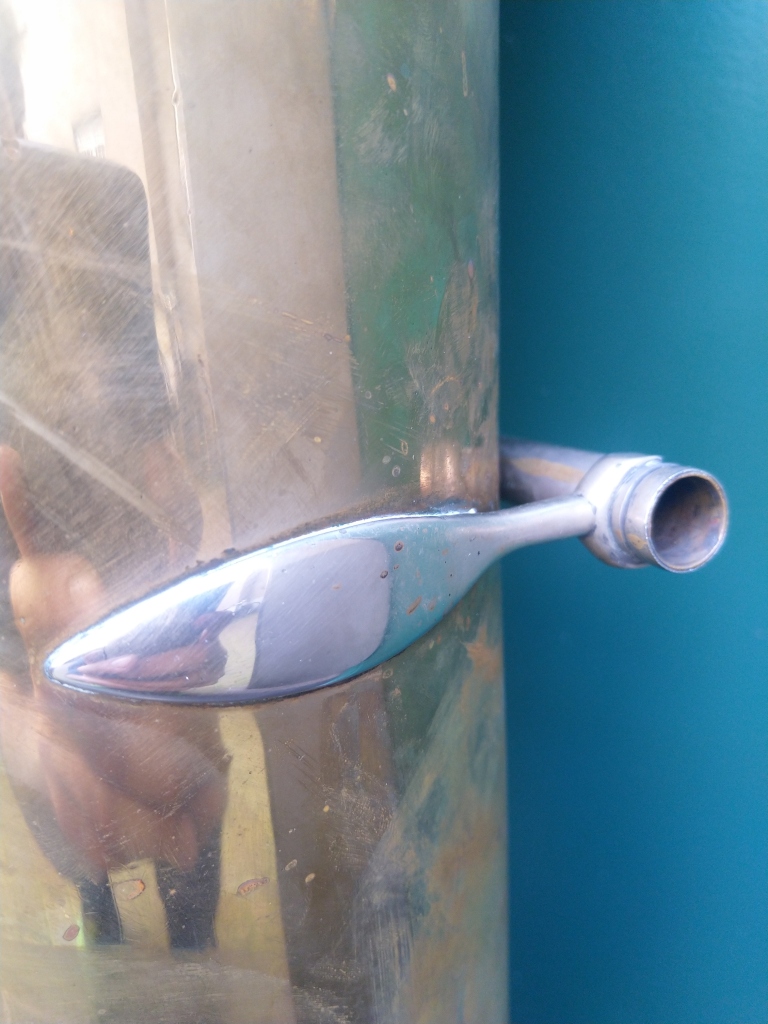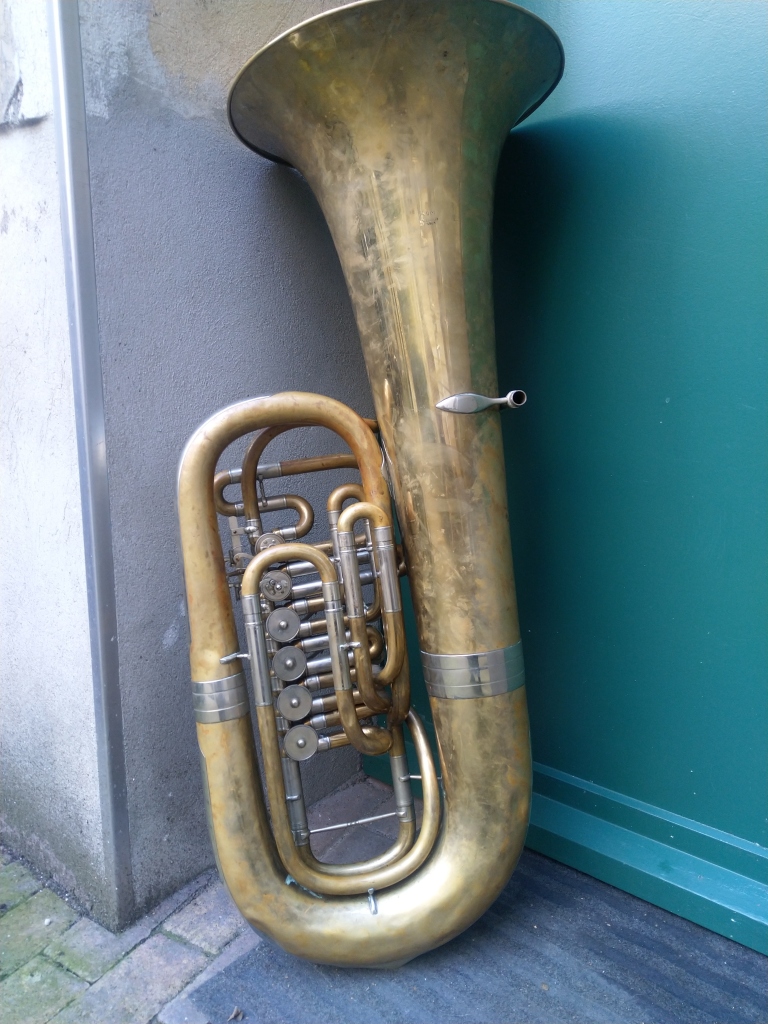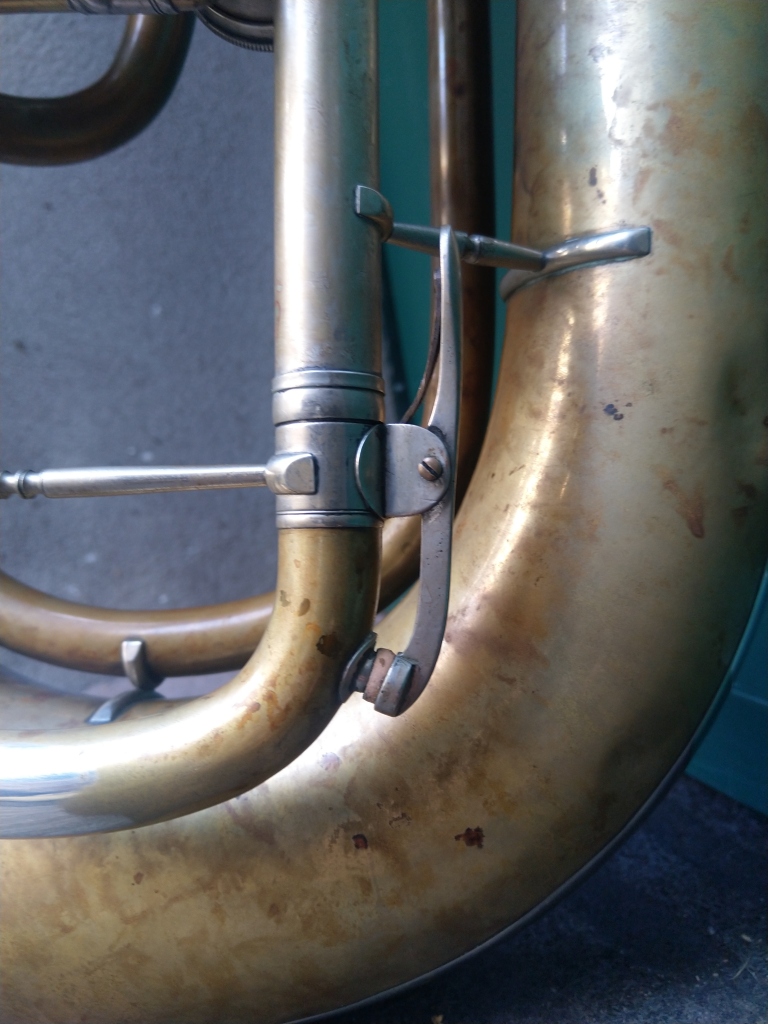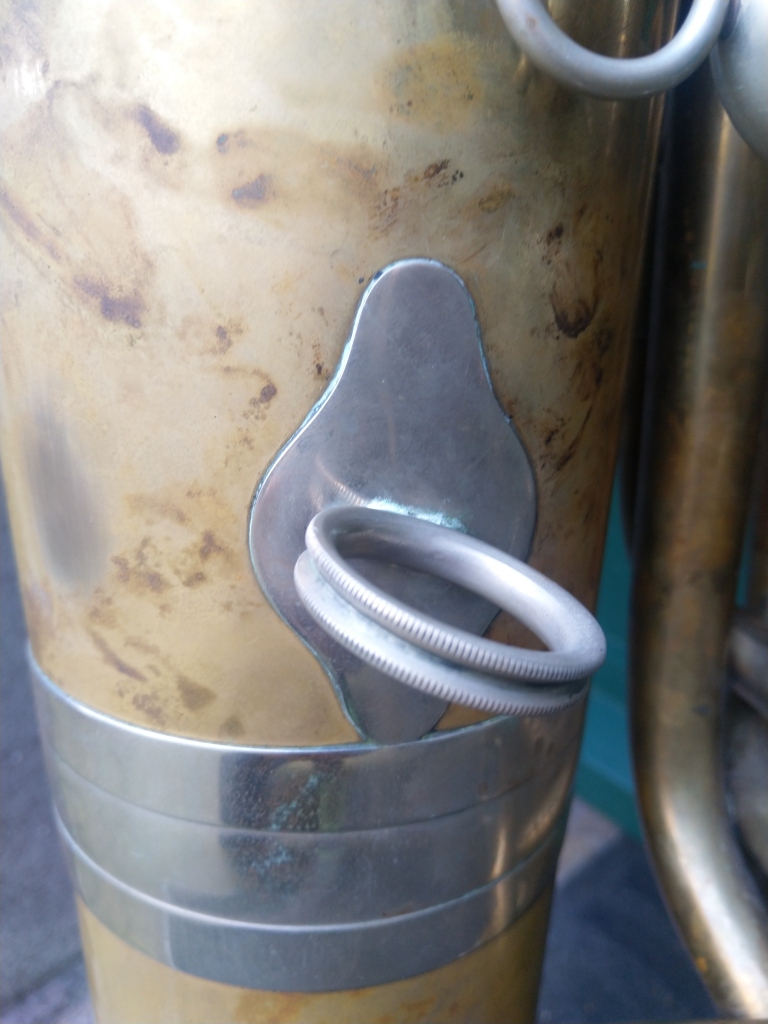As long time readers of this blog might recall, I’ve frequently discussed the earliest ca. 1960 B&S Symphonie F tubas as well as the earliest DDR made1948 VEB F-Tuba, but I’ve yet to bring up the various prototypes that were explorations before the design settled on the 1960 Cerveny based model which eventually went into production as the Symphonie. Between 1948 to 1960, the former Hess, VEB (eventually becoming B&S) workshop built a number of custom F-tubas in various configurations.
The vast majority of these prototypes were considerably smaller than the Symphonie, both in bore and body size, usually a modified B&S Model 92 as they were later known. To be brutally honest, most of the prototypes left much to be desired in terms of playability. My recently retired colleague Georg Schwark of Rundfunk Berlin fame, had just such an instrument when he first started playing tuba. It was in his words, “a dreadful instrument, that could be made to work, but required great concentration”. He went on to mention that after receiving a new Symphonie, he considered leaving the old VEB on the street corner because “I would have felt bad selling it to a friend”. Clearly those tubas had room for improvement.

The design of the pre 1960 Fs were carried over from the previous Hess firm in Klingenthal. Like the Hess, these early tubas were based off of designs brought from Alexander by designer Cronlein in the 1930s. Like the Alexander F-tubas the Hess and later VEB versions all seemed to suffer from similar issues, such as general intonation and poor response, especially in the infamous F-Tuba low register D-Db-C. Clearly the 1950s VEB factory to their credit were likely aware of these issues, as the various prototypes I’ve seen, kept improving on these fronts.
When this tuba first came into the workshop, I was quite puzzled. It was obviously an early B&S F-Tuba, but while not a Symphonie, it was far larger than any other model I’ve previously seen. Even more confusing was the valve block and paddle assembly. The quality of the components was finer than 1950s VEB, indicating the tuba might have been made by Hess in the 1930s, but I’ve never seen such a large modern style F Tuba from Hess. Luckily I could call my dear colleague in Frankfurt an der Oder, the firm Dobberstein as they have quite a bit of experience with Hess and early B&S instruments. Dobberstein went on to suggest something I had not considered. In the 1930s Hess had produced a rather large reserve of spare parts and after WW2 the VEB factory were using these parts well into the 1950s, which goes a long way to explain the beautful paddles/linkage and waterkey on this tuba.
However what remains most compelling about this instrument is the body. The bell is in all intents and purposes almost identical to a later Symphonie, but rather than a 42cm end diameter, 38cm, which has a dramatic effect, as you will see in the end. Basically the bell stops where the Symphonies bell kranz begins. Like the Symphonie, the bell is a one piece construction(with gusset) and is made of goldbrass with a steel bead in the rim.
The bottom bow is even more interesting. It is like the bell, identical to that of a Symphonie in dimensions. However the construction is considerably different. While Symphonie bottom bows are made of two adjoined mirror pieces, which are then brazed together and “opened up” to their final form, this prototype looks to have been constructed of a single sheet of goldbrass which was then formed into a cone shape, filled with lead and bent into its final form. It seems the VEB still had people who could make bottom bows in this fashion even in the 1950s.
The top bow is where things start to diverge. While similar to the Symphonie, the smaller side of the top bow takes into account the smaller sized valve block (18.50mm vs 21mm) and tapers at a far faster rate, resulting in a smaller top bow and narrower tuning slide. The valve block itself is a cylindrical bore of 18.50mm and features the somewhat more restrictive porting of the 1930s Hess block(compared to the later 1970s B&S style).

The leadpipe itself shares more in common with earlier VEB designs than the Symphonie. The taper stretches over a 60cm length (about 50cm +- for the Symphonie) and features a more gradual taper rate from 14 to 18.50mm rather than 13 to 18mm for the Symphonie, clearly something quite different. The receiver, like many mid 20th century DDR F-Tubas uses a bass trombone sized shaft and is the time honored sleeve system. The nice forged nickelsilver bell to leadpipe brace is lovely to look at when compared to the modern stamped versions.

Before moving on, a quick note regarding the valve tubing layout. Many of the various F-Tubas from Markneurkirchen/Klingenthal with 5 or 6 valves, used this interesting layout for the 5th and 6th valves. Unlike the Alexander, which runs vertically, the various VEB/B&S/Knoth/Knopf/Wunderlich decided to run a horizontal side loop. Who ever came up with this design initially is of yet unknown. The advantage is that it is far easier to built than most traditional setups and allows a more open wrap. However it does expose the 5th slide to direct impacts and over the years, I’ve noticed this tuning slide tends to have brutal damage due to its location. What remains odd to me, is that the design never spread beyond Sachsen for some reason and by the time the Symphonie came out, it virtually vanished. I say this as I’ve compared a number of Alexander 155s to the various Markneukirchen versions and these always had more open 5th valves. Whether or not it was the 5th valve tubing is another discussion, but it was something to keep in mind.

Unfortunately our featured tuba is not in the best of condition. Although generally free of structural damage, someone has lapped the valves to the point of needing a rebuild. While funds are not there at the moment, I managed to pour a tablespoon of heavier oil into the valves to get a general idea of the playing characteristics. What I found was quite a surprise as the tuba has a substantial deep voice, with more bass in the sound than even a Symphonie or modern B&S F-Tuba. As you work your way into the lower range, the typical D, Db etc are far superior to the earlier F-Tubas, but still not quite at the Symphonie’s level. However this is not to say its bad at all. If you have experience with old Alexander F-Tubas, this would be a walk in the park for you. Playing lower results in increased resistance, till at somepoint, you begin to understand why the Symphonie has a conical bore…

The only other issue is the C in the middle of Bass clef. This as I mentioned is an issue with almost any smaller B&S F-Tuba, and while this one is better than most, it’s still too sharp for my taste. While I have far too many other projects at hand, my curiosity got the better of me and I did a short experiment. I took an extra Symphonie 42cm kranz and taped it onto this tuba’s bell. Low and behold, the C was suddenly in tune, demonstrating the effect of end bell diameter. Hindsight is 20/20…
Specs: ca. 1950s VEB Prototype F-Tuba Klingenthal
Height: 90cm
Bell Diameter: 38cm
Valves: 18.50mm bore 6 valves nickelsilver casings and trim
Weight: 8kg
Body: Goldbrass generally 0.60mm wallthickness








So sorry about the loss of your friend.
Thank you Hal